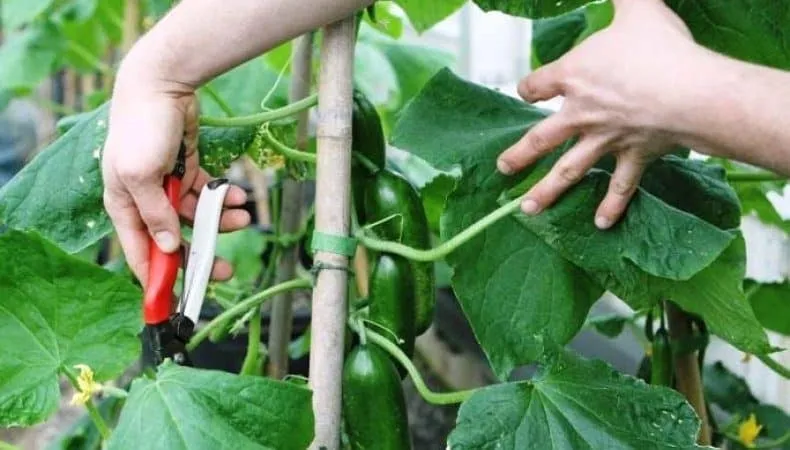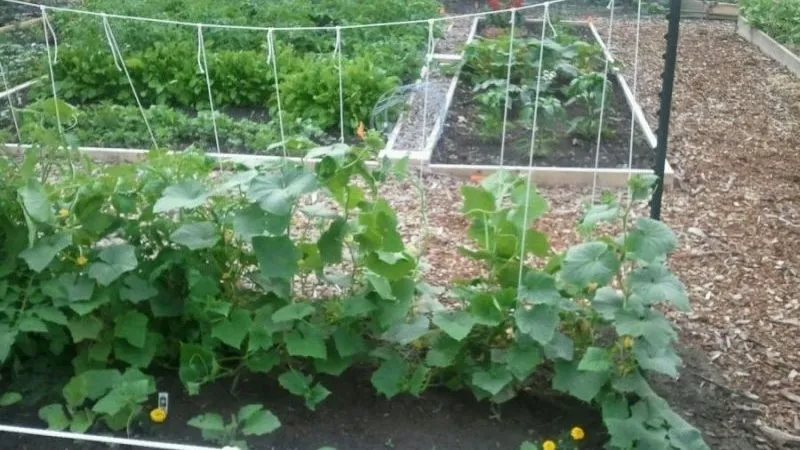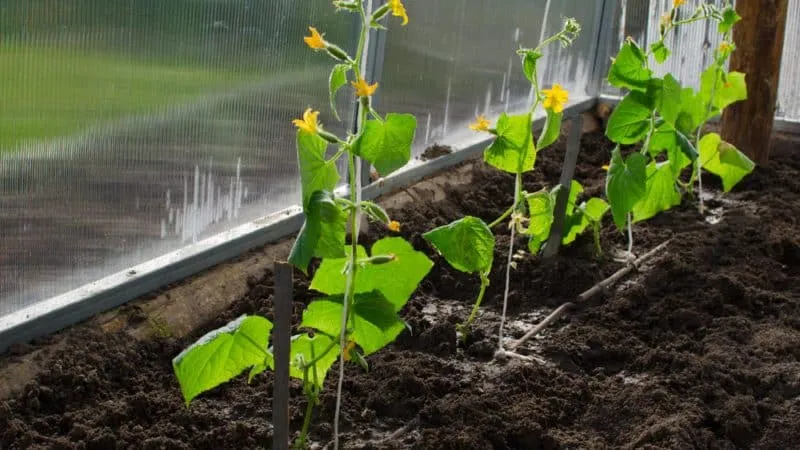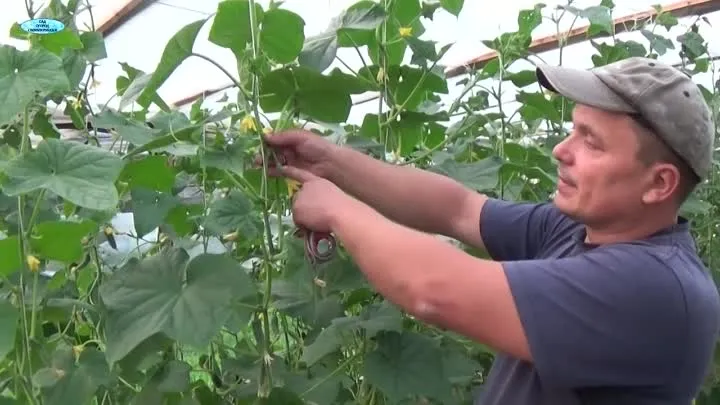Many dream of a bountiful harvest, but not everyone knows that one way to increase cucumber yield is by pruning the leaves. Why and how to do this correctly — we’ll explain in detail.
Table of contents
Should You Prune Cucumber Leaves in a Greenhouse and Why?
Pruning leaves and shaping bushes is a sensible and effective method for improving crop quality. Uncontrolled plant growth leads to an excess of male flowers (empty blooms), and the cucumber vine starts branching, making maintenance difficult.

Advantages of Shaping Cucumber Bushes
Pruning leaves increases yield and improves fruit taste because the plant doesn’t waste energy on vine growth:
- New ovaries form faster;
- Cucumbers lose their bitterness;
- Fruits develop a uniform shape;
- Less water is needed for irrigation;
- Air circulation improves;
- Better access to roots for weeding and loosening;
- Easier harvesting.
By trimming excess leaves, you reduce bush density — the plant receives more light and better ventilation, lowering the risk of fungal diseases.
The choice of shaping method depends on the cucumber variety (parthenocarpic or bee-pollinated), maturity period (early, mid, or late-season), planting method (row or staggered), and trellising (vertical, horizontal, or net).
Note. In greenhouses, cucumbers are typically shaped into a single stem, while in open ground — into two or three vines.
Key Principles of Pruning in a Greenhouse
Greenhouse seedlings quickly develop vegetative mass — stems, leaves, flowers, and ovaries. Nutrients are evenly distributed along the vine — removing excess shoots and leaves improves nutrient flow to the ovaries.

Experienced gardeners recommend following these general pruning principles for greenhouse cucumbers:
- Shape the bush no earlier than 10 days after planting.
- Start shaping with trellising.
- Use only sharp, sterilized tools (boiled for 5-10 minutes) — breaking shoots by hand can damage the plant.
- Trim shoots close to the stem, leaving no stubs.
- Prune regularly as the bush grows — at least once a week.
- Perform the procedure in the morning so "wounds" heal by evening, reducing infection risk.
- Ensure the air temperature is at least 20°C.
Handle the central stem carefully — damaging it can kill the plant.
Timing for Shaping Cucumber Bushes
There’s no exact timeframe, but the best period is about three weeks after transplanting into the greenhouse, when vines reach 50 cm. Delaying pruning leads to overgrowth and tangled shoots.
If the bush grows uncontrollably, trim side shoots once they reach 5-6 cm — this is safe for the main stem and minimally stressful for the plant.
Trellising Methods Before Shaping

Trellising involves securing and guiding cucumber vines along a support. A trellised plant makes it easy to identify the main stem and side shoots.
Trellis cucumbers when the vine has 4-6 leaves and reaches over 30 cm in length. Construct a support system to shape the bush and free up garden space.
Important! Install supports before planting cucumbers.
Materials needed for trellising:
- 2-meter wooden or metal stakes;
- Twine or cord;
- Plastic netting;
- Hooks for fastening;
- Anchor pegs;
- Soft fabric strips (cotton, knit) 3-4 cm wide;
- Tools — hammer and pliers;
- Nails.
Avoid thin wire — it can damage plants.
Several trellising methods exist — let’s explore each.
Vertical Trellising

This method provides individual support for each plant:
- Set up a U-shaped frame (2 m tall) at the ends of the bed — add a middle support for long beds.
- Attach twine to the top bar (one per plant).
- Stretch the twine down and anchor it with pegs near the base.
- Gently wrap the stem clockwise around the support.
- Secure the plant with fabric strips.
Horizontal Trellising
Ideal for open ground or low tunnels:
- Install 1.5-2 m stakes at both ends of the row.
- Run horizontal twine lines 30 cm apart from the ground up.
- Guide young vines to the bottom line, securing them loosely with fabric.
Disadvantage: Once vines reach the top, they can’t climb further and may shade lower growth.
Net Trellising

Garden nets with large mesh are widely available and easy to install:
- Set up 2.5 m posts at each end of the bed.
- Stretch and secure the net between them.
- Guide vines onto the net, using fabric strips if needed.
Train vines loosely to avoid uprooting. Leave the top free to prevent yellowing.
Pruning Techniques
The method depends on the cucumber variety.

Parthenocarpic Varieties
These hybrids produce fruit without pollination. About one-third of the yield forms on the main stem, the rest on side shoots.
Pruning sequence:
- Divide the stem into four zones, starting from the bottom.
- Zone 1: Remove side shoots and flowers between the 2nd-4th leaves (keep leaves).
- Zone 2: At ~70 cm stem length, trim side shoots only (keep leaves and flowers), leaving one ovary and leaf per stem.
- Zone 3: At 120-130 cm (10th leaf), remove shoots above it. Keep two flowers and two ovaries per three nodes.
- Zone 4: Above the 12th leaf, trim all ovaries and leaves, leaving three ovaries and three leaves per 50 cm of side shoots.
- Pinch the top to stop growth and secure to the trellis.
Pinching means shortening the shoot.

Bee-Pollinated Varieties
These require pollination, so they’re grown in open greenhouses. Experts recommend single-stem shaping like parthenocarpics.
Ovaries form on side shoots — use gentle pruning:
- Don’t trim the main stem until it reaches the top trellis.
- Remove only the first two side shoots.
- Trim shoots at 4-5 leaves, keeping 3-4 flowers.
- At the trellis top, allow side shoots to grow 50 cm — wrap the main stem around the bar and pinch side shoots.
Remove brown, yellow, or damaged leaves anytime.
How to Prune Cucumbers Correctly
Avoid repositioning vines during pruning to prevent breakage.
Should You Remove the First Leaves?
Removing early leaves can reduce yield — the first 3-4 true leaves determine future flower production.
Do Cotyledon Leaves Need Removal?
Cotyledons (seed leaves) appear during early growth and fall off naturally. Don’t remove them — they’re vital for seedling development.
Pruning Lower Leaves
Only prune lower leaves on healthy, lush plants — sparse bushes may suffer. Trim leaves 20-25 cm above soil level to reduce humidity and fungal risks.
Should First Flowers Be Removed?
Experts recommend thinning male flowers (empty blooms) to conserve energy — keep 1-2 per vine. Never remove female flowers — they become ovaries.
Removing First Ovaries
Early lower ovaries develop slowly. Removing them (keeping those 80-90 cm up) directs energy to stem and root growth.
Which Shoots to Trim for Best Yield
Remove:
- Ground-contact shoots;
- Non-fruiting side shoots;
- Old, yellowing vines;
- Stems with deformed fruit.
Conclusion
Leaf pruning is essential for plant health and yield: excess foliage won’t steal nutrients; sunlight reaches all leaves for better photosynthesis; air circulation reduces disease risk.
Proper, timely pruning is crucial — your reward will be a generous cucumber harvest.







